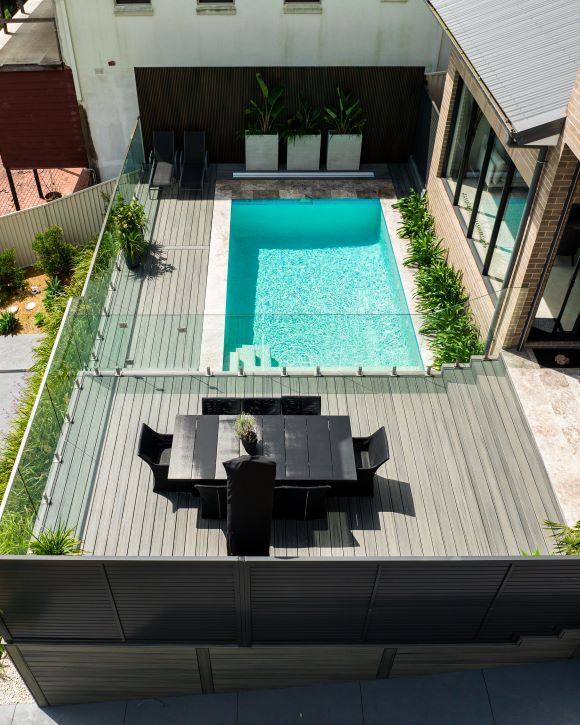
Is Composite Decking Worth It?
Are you considering building a new deck for your home, but unsure whether to choose traditional wood or opt for composite decking boards? Both options have their merits and drawbacks, making the decision a challenging one. In this blog post, we’ll explore the pros and cons of wood vs composite decking, helping you make an informed decision based on factors such as maintenance, durability, style, and environmental impact, ultimately answering the question: “is composite decking worth it?”
Pros & Cons of Timber vs Composite Decking (2023)
Key Takeaways
Composite decking offers low maintenance, durability & longevity, and style & color options.
Wood decking requires high maintenance and is prone to insect damage & rot with a shorter lifespan than composite materials.
Composite decks have higher initial costs but can be cost effective in the long run. Installation tips should be followed for best performance.
Timber decking is an environmentally friendly decking
Composite Decking: The Advantages
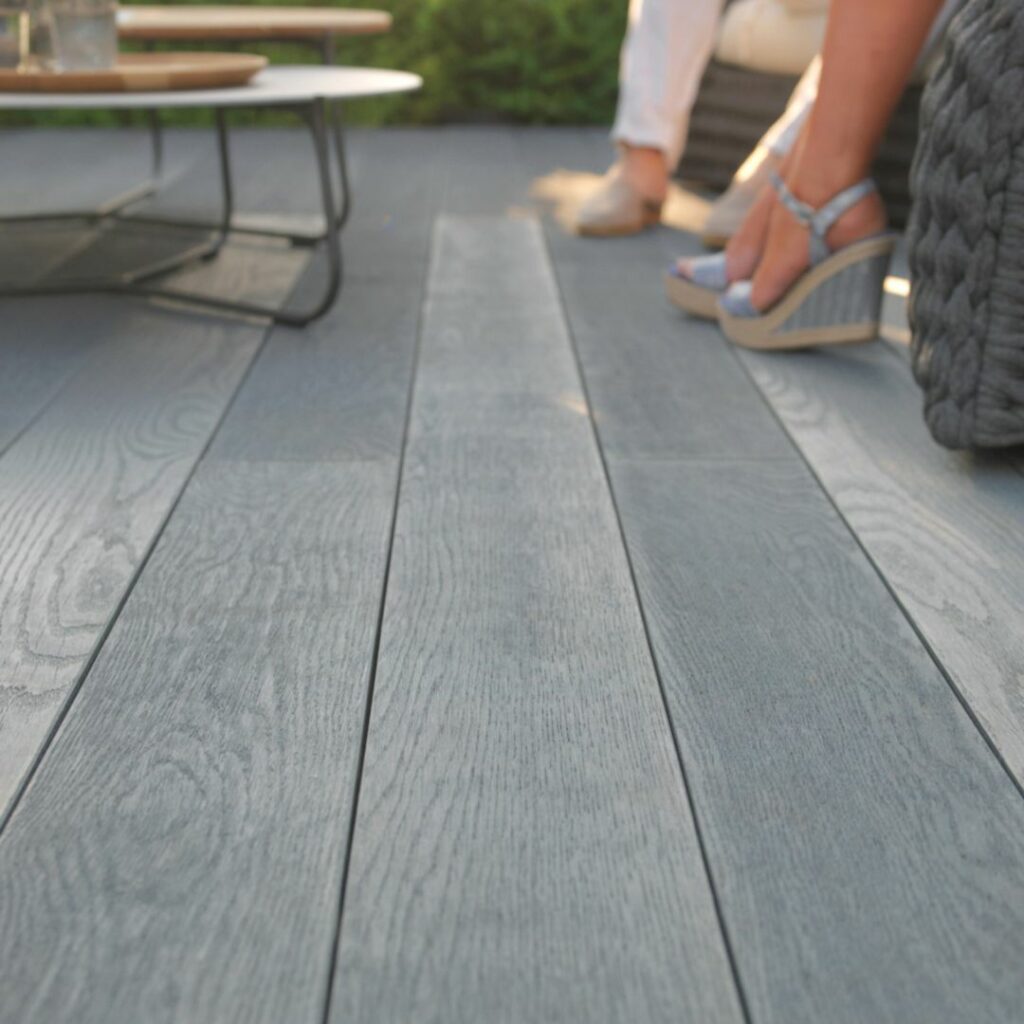
This material type offers a range of benefits that make it an attractive alternative to traditional wood decking. With low maintenance requirements, enhanced durability and longevity, and a wide array of style and color options, composite boards provide a compelling solution for homeowners looking to upgrade their outdoor space.
Low Maintenance
Its low maintenance requirement’s is one of its most appealing aspects. Unlike natural wood, which requires regular sanding, cleaning and oiling to maintain its appearance, composite deck material needs minimal upkeep. This means that you can spend more time enjoying your deck and less time on laborious maintenance tasks.
Unlike timber decking, composite decking offers several advantages:
It withstands all weather conditions without deteriorating in direct sunlight or being adversely affected by the weather.
It doesn’t require coatings or sealing for environmental protection.
With only simple cleaning and occasional inspections for damage, it remains in pristine condition for years to come.
Durability & Longevity
Composite decking material offers superior durability, lasting for extended periods with minimal maintenance. It is resistant to rot, insects, and fading, ensuring that your deck remains in top condition for much longer than natural wood alternatives.
With an estimated lifespan of 20 plus years without significant upkeep, composite decking stands as an ideal choice for a durable, low-maintenance outdoor space. It is also designed to resist fading, maintaining its original appearance and “like new” looks for years.
Style & Color Options
Beyond its practical benefits, it also offers a diverse range of colors and styles to match your personal taste and your home’s exterior. From neutral tones to vibrant hues, you can customize your composite deck to create a unique, stylish outdoor space that reflects your individual preferences.
Timber Decking: The Drawbacks
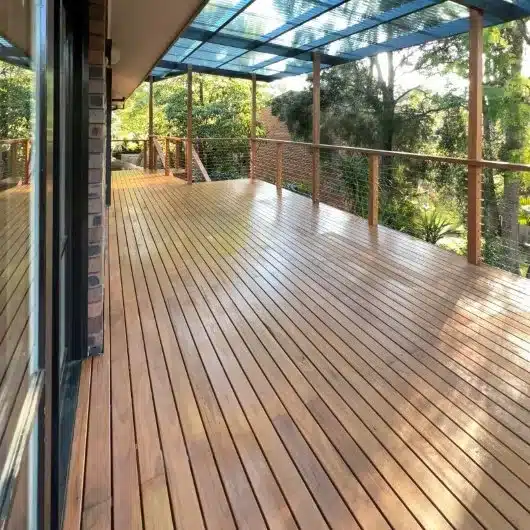
While it has its charm, it also comes with several drawbacks. High maintenance requirements, susceptibility to insect damage and rot, and a shorter lifespan are just a few of the challenges homeowners face when opting for natural timber decking.
High Maintenance
Wood decks require regular maintenance to maintain their appearance and prevent damage. This includes cleaning, staining, and sealing, which can be time-consuming and costly. Moreover, it is also prone to weather-related issues, such as warping and splitting, which can further increase maintenance costs and efforts. It’s essential to consider these factors when choosing a wood deck for your outdoor space.
Contrastingly, with its minimal upkeep, composite decking stands as a more cost-effective and time-saving option for homeowners who want to enjoy their outdoor space without the maintenance hassle.
Insect Damage & Rot
Wooden decks are susceptible to insect damage and rot, which can compromise their structural integrity and aesthetics. Insects such as termites, carpenter ants, and powderpost beetles can cause significant damage, weakening boards and even leading to the collapse of the deck.
In addition to insect damage, wood decking is also vulnerable to rot caused by moisture, fungus, and water damage. This can result in cracking and splintering, negatively affecting the deck’s appearance and stability.
In contrast, composite decking resists these issues, offering a more durable and long-lasting solution.
Shorter Lifespan
Wood decks typically have a shorter lifespan than composite decks, often requiring replacement after just 10-20 years. Factors that can contribute to a shortened lifespan include:
Irregular maintenance
Exposure to rain and moisture
Use of low-quality or untreated wood
Harsh climate conditions
Lack of protection against UV rays
Composite materials offer several advantages over timber decking:
Superior durability
Low maintenance requirements
Cost-effective
Long-lasting alternative
Estimated lifespan of 25 plus years
With composite materials, homeowners can enjoy their outdoor space for longer without the need for frequent replacements.
Composite Decking: The Disadvantages
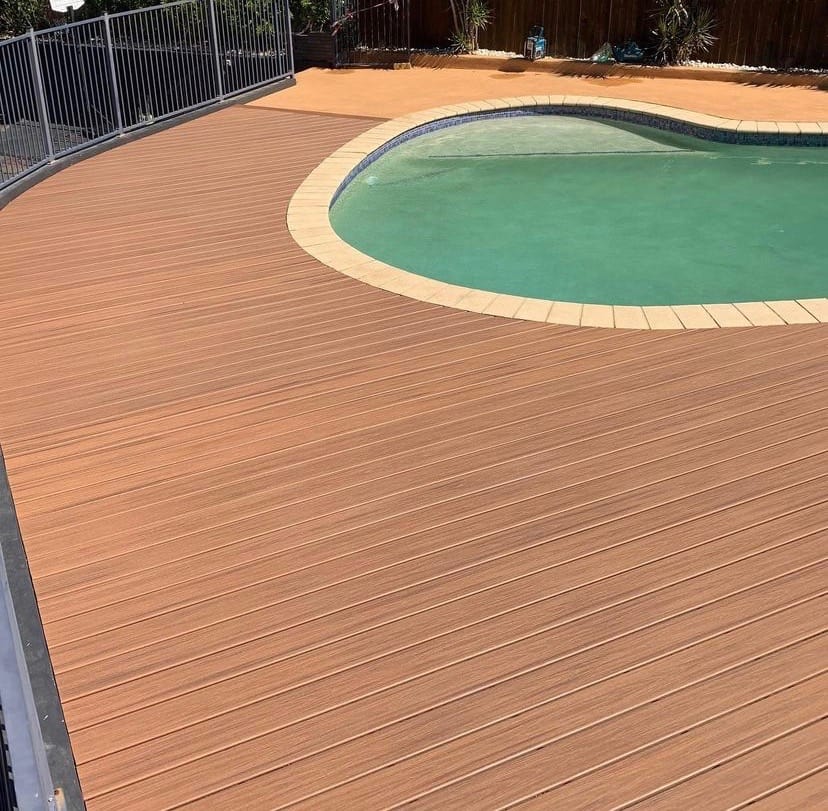
Initial Cost
Despite its many benefits, there are some cons to consider. These include higher initial costs, heat retention, and a less natural appearance compared to a traditional wood deck.
It generally has a higher initial cost than timber decking, with estimates ranging from $100 to $350 per square meter for the deck boards alone. This can be a significant investment for homeowners, especially when compared to the lower upfront costs of timber decking.
However, the long-term savings associated, including reduced maintenance and replacement costs, should be taken into consideration. When taking these factors into account, the higher initial cost of composite decking may be offset by its long-term benefits and cost-effectiveness.
Heat Retention
One potential drawback is its heat retention. Due to the materials used in its construction, some composite decks can become significantly hotter than wood decks when exposed to direct sunlight. This can make the surface uncomfortable to walk on with bare feet during hot weather.
To offset this issue, lighter-colored material, which reflect sunlight and maintain a cooler surface temperature, can be chosen by homeowners. Alternaively, choose a PVC composite deck boards that sheds its head load and is significantly cooler than some other composite deck boards. Additionally, strategically placed shade structures, such as pergolas or umbrellas, can help keep the decking surface cooler during the hottest parts of the day.
Artificial Appearance
Some deck boards made from composite material, may have an artificial appearance, lacking the natural look and feel of real wood. This can be a concern for homeowners who prefer the aesthetic of traditional timber decking, including deck boards, over composite materials.
Nevertheless, technological advancements have given rise to options that closely resemble the look of natural wood, offering a more authentic look for those who appreciate the visual appeal of wood.
Environmental Impact: Comparing Wood and Composite Decking
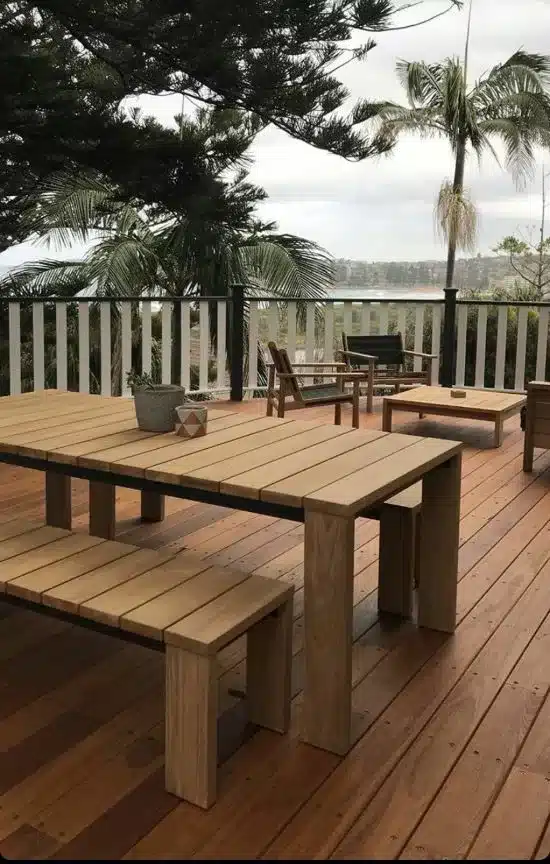
When considering wood and composite decking options, it’s important to take into account their environmental impact. Factors such as recycled content, sustainability, and waste generation all play a role in determining the eco-friendliness of each decking material.
Recycled Content
Composite decking often contains a high percentage of recycled material, reducing waste and promoting sustainability. Some examples of recycled materials used include:
Reclaimed timber
Sawdust
Wood waste
Recycled plastic
By using these materials, brands help to minimize their environmental footprint.
The use of recycled material in composite decking offers several environmental benefits, including:
Repurposing plastic waste
Reducing reliance on single-use plastics
Decreasing deforestation
Minimizing landfill waste
These factors make it an environmentally friendly choice for homeowners looking to minimize their ecological impact.
Sustainability
The sustainability of wood and composite decking is an ongoing debate. Here are some key points to consider:
Timber decking is a renewable resource.
Composite decking is made from a combination of recycled materials, plastic, and wood fibers.
The environmental impact of both wood and composite decking is contingent upon the type of wood used and the manufacturing process.
Some manufacturers prioritize the use of eco-reclaimed pine or sustainable timber sources, while others, such as Trex and Millboard, are dedicated to utilizing recycled materials in their products, diverting plastic from landfills, and avoiding additional tree cutting. Researching individual manufacturers to gain insight into their specific sustainability practices is crucial.
Waste Generation
It’s important to consider the waste produced during the creation and disposal of decking materials when comparing wood and composite options. Composite decking manufacturing is often energy-efficient and produces little waste. However, these materials are typically not recyclable and must be disposed of via incineration or landfill. This can lead to increased waste generation and potential pollution, negatively impacting the environment.
Some manufacturers have introduced recycling initiatives and take-back programs to collect and recycle old materials, thus reducing their environmental impact.
Cost-Benefit Analysis: Is Composite Decking Worth the Investment?
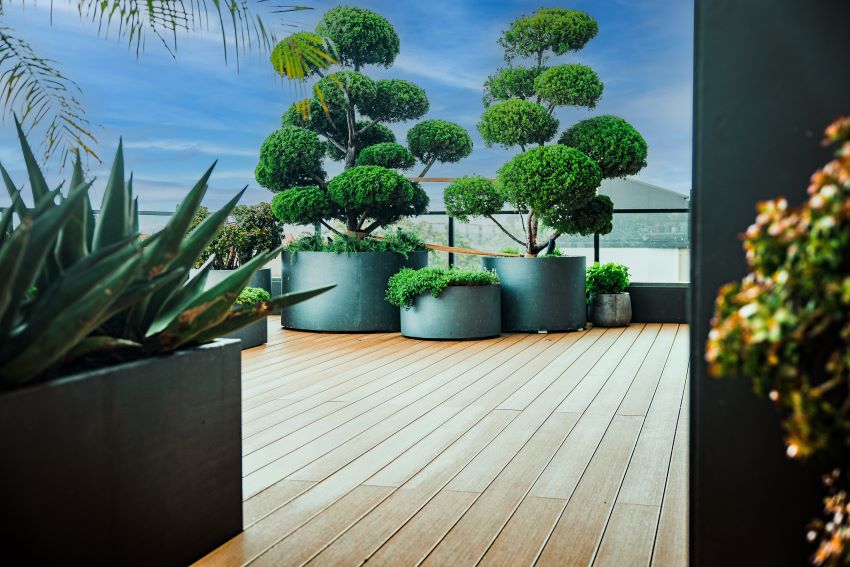
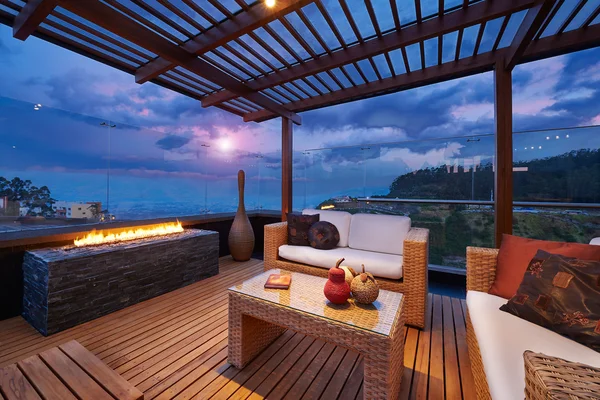
Performing a cost-benefit analysis to compare upfront costs, long-term savings, and value for money is crucial in determining if the investment is worthwhile. This can help homeowners make an informed decision about whether the advantages of composite decking outweigh its disadvantages.
Upfront Costs vs Long-Term Savings
While composite decking has a higher initial cost than Timber decking, ranging from $100 to $350 per square meter, the long-term savings on maintenance and replacement can make it a more cost-effective option. It requires only minimal upkeep and is more durable and resistant to rot, mold, and pests than timber decking, resulting in lower maintenance and replacement costs over time.
Composite decking has an estimated lifespan of 25-30 years, allowing homeowners to enjoy their outdoor space for longer without the need for frequent replacements. This extended lifespan, combined with lower long-term maintenance costs, can help offset the higher initial investment of composite decking.
Value for Money
With its durability, low maintenance requirements, and extended lifespan, composite decking provides better value for money compared to traditional wood decking. While the initial cost may be higher, the long-term savings on maintenance and replacement, as well as the environmental benefits of using recycled materials, make it a wise investment for homeowners seeking a stylish, practical, and eco-friendly outdoor space.
Top Composite Decking Brands
Choosing a reputable brand that offers high-quality and eco-friendly options is essential when selecting the best composite deck boards for your home. Some of the top composite decking brands include:
These brands provide durable, long-lasting composite decking solutions that are resistant to fading, staining, and mold, ensuring your outdoor space remains beautiful and functional for years to come.
Installation Tips and Best Practices
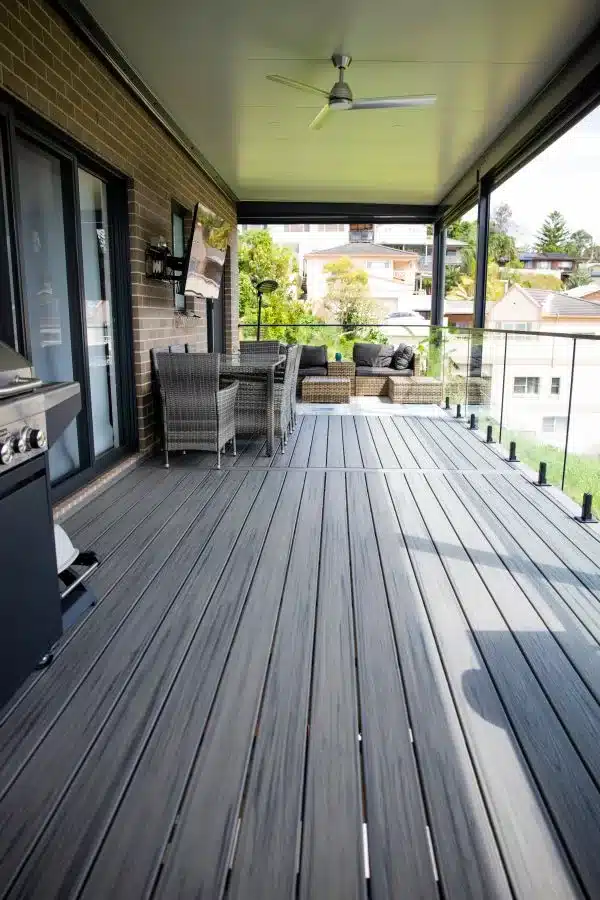
Ensuring the longevity and performance of both wood and composite decking materials requires proper installation and adherence to best practices. For wood decking, it’s essential to use stainless steel screws, pre-drill holes, and use a level to ensure the deck is even.
Similarly, when installing composite decking, it’s recommended to use hidden fasteners, pre-drill holes, and use a level to guarantee the deck is level. By following these installation tips, you can enjoy a sturdy, long-lasting deck that maximizes the benefits of your chosen material.
Summary
Both wood and composite decking have their unique benefits and drawbacks. While timber decking offers a natural and traditional aesthetic, it comes with high maintenance requirements, susceptibility to insect damage and rot, and a shorter lifespan. On the other hand, composite decking boasts low maintenance, enhanced durability, a longer lifespan, and a wide array of style options. Although composite decking has a higher initial cost, its long-term savings on maintenance and replacement make it a more cost-effective and environmentally friendly option. By considering these factors and conducting a cost-benefit analysis, you can make an informed decision on the best decking material for your outdoor space. Consult your deck builder for more in depth advice.
Frequently Asked Questions
What is the downfall of composite decking?
Some Composite decking is heavier and less structurally strong than traditional wood, resulting in the need for additional framing support to stop boards sagging and bending.
Is it worth getting composite decking?
Yes, it is worth getting composite decking as it is significantly more durable than traditional wood and requires much less maintenance. Additionally, composites have a longer lifespan of up to 30 years, compared to the usual 15 years from wooden decking. Finally, they often cost more but deliver greater durability and less maintenance, making them a better investment in the long-term.
What is the typical lifespan of composite decking compared to timber decking?
Composite decking typically lasts between 20-30 years with minimal maintenance, significantly longer than wood decking’s 10-20 year lifespan with regular maintenance.
What maintenance tasks are necessary for composite decking?
Regular sweeping, prompt cleaning of spills and stains, avoiding abrasive cleaners and pressure washers, and inspecting for damage and replacing damaged boards are all necessary maintenance tasks for composite decking.
How can I minimize heat retention on my composite deck?
Opt for lighter composite decking materials and install shade structures, like pergolas or umbrellas, to minimize heat retention on your composite deck.
I'd like some more information


